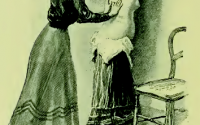Pain & Relationships with Your Client
Pain & Relationships with Your Client by Art Riggs
A few years ago, Tom Myers wrote an interesting article about pain in which he focused upon the subjective qualities of discomfort that our clients experience in bodywork. I particularly liked Tom’s metaphor of three kinds of pain:
– Pain entering the body—from injury or other external causes, including too aggressive work
– Pain stored in the body’s tissues
– Pain leaving the body
This subject is often neglected in training–I think partly because it is such a subjective sensation but, also, because pain is a bit like the black sheep relative that everyone in the family feels uncomfortable acknowledging.
In this article, I would like to focus upon our role as therapists to facilitate the “release of pain stored in the body” and some practical ways of skillfully dealing with these sensations in our relationships with our clients. Even if our bodywork practice is primarily relaxation and enjoyment based, the reality is that virtually all people we see have areas of dysfunction, discomfort, or actual pain somewhere in their body. If we fail to address these issues, we do a disservice to our clients and limit the success of our practice. One of the most frequent complaints I hear from people asking for referrals is that overly conservative massage is ineffective in providing long-lasting benefits and in dealing with chronic pain in the body. Conversely, I also hear criticism of over-zealous therapists who impose unnecessary discomfort (the first of the three pains listed above), primarily from poorly developed skills of touch, but also because of less than satisfactory attention to the emotional aspects of pain and the subjective connection of trust one has with a client.
Spend any time watching daytime TV and you will see countless commercials offering relief from pain. Pain is the enemy and is almost always looked at as a sign that something is wrong, so we are offered opiates to dull the sensations rather than addressing the causes. I prefer to look at symptoms of discomfort as the “canary in the mine shaft” alerting us of a potential problem. We all frequently have the experience of encountering congested tissue that our clients express surprise at the tenderness and admiration for our skills at discovering these secrets. Finding these areas is the preliminary skill, but the release of these patterns requires even more finesse to mitigate the symptoms and their causes rather than increasing discomfort from our work.
Scientific literature is replete with attempts to measure the specific quantitative aspects of pain. I recently had a physical therapist in a workshop ask how many ounces of pressure in a localized area of how many square inches delivered at how many centimetres per minute would elicit a pain response and the inevitable rebound of tissue? Teaching can indeed be a challenging experience at times! Such a question ignores the intangibles of touch and vast differences between clients. Although our manual skills are to a large extent specific and measurable, our clients’ perceptions of our touch are extremely varied, subjective, and in many ways contingent upon the intangible aspects of our humanity and relationships with them.
I will focus upon your connection with your clients and how your relationship can affect the greatly varying subjective aspects of their perception.
YOUR RELATIONSHIP WITH YOUR CLIENT
Pain, either “stored in the body” or arose from your touch does not exist in a vacuum. Most all of our perception of this sensation is influenced by context. Think of the difference in perception between being stuck with a needle accidentally and the careful probing to remove a splinter. The context of your relationship with your client and your intention can provide the confidence and caring that can make the difference between a tense and painful session or a relaxed and easy one as they realize the benefits from focused work to solve problems.
Since our bodies and minds are conditioned to interpret pain as the messenger that “something is wrong here!” fear is often the primary emotion that we deal with when working deeply with our clients. The first few minutes of your session can be your major tool in allaying fear and the tension in the body caused by this emotion. Following, are some suggestions for consideration:
Establish rapport
Taking just a few minutes to chat with your clients, especially if it is the first time you have seen them, can define the context of everything you do in the session. A few minutes of relaxed conversation, and not necessarily only about “business,” can let your client feel like a person you actually care about on a personal level and begin to establish a relationship based upon mutual trust.
Cultivate confidence in your skills
Rather than immediately beginning work on sensitive or troublesome areas of complaint, address areas that will “feel good” and let your client become familiar and relaxed with your touch in an area where they feel safe.
Explain the rationale behind your strategies, especially in areas that are sensitive. Intense therapy with a purpose will be perceived very differently from work that appears to be insensitive and without benefit.
Give a feeling of empowerment to your client.
The most important gift of safety you can give to your clients is the knowledge that you will stop immediately if they ask you to. However, there is a delicate balance between being receptive to feedback and appearing to be under-confident. Constantly asking your client if the work is too intense can call attention to the issues of pain. The client should be able relax with confidence rather than having to be overly vigilant in giving feedback.
We will discuss this in more detail in the next article on this subject, but suffice it to say that your session will be much smoother and enjoyable if you err towards the side of caution rather than overworking and having to interrupt the flow of the session by frequently stopping work and having to regain the confidence and relaxation of your clients after over-stimulation. Cultivate your sensitivity to the preliminary signs of defensive withdrawal rather than crossing the threshold into painful territory.
Pace your sessions and clarify your goals
Good (overly ambitious) intentions can lead to trouble. I joke with my friends that they need to beware of my enthusiasm as I try to give them “extra” work. I wish I could give recall notices to my early clients as I watched them levitate off the table as a result of my “over-generous” attempts at being a miracle worker. Probably the single largest cause of overworking or causing discomfort is not the error of working too deeply or applying too much pressure, but of working too fast. Choose your goals before beginning work and don’t get sidetracked by trying to accomplish too much in limited time and working faster than the tissue can easily melt.
A friend once gave me some excellent advice from a Buddhist teacher: “In life, as in music, the rests are as important as the notes.” I apply this wisdom to my sessions. When performing intense work, I give frequent breaks for my clients to assimilate the changes and enjoy integrative and “feel good” work. This allows for a rest and the chance to appreciate and solidify the good work you have performed.
Consider Einstein’s wisdom on the relativity of time. I learn a great deal when I go to yoga classes. As I look around the room, I see the lithe young things who appear to be warming up for their primary jobs as contortionists for Cirque du Soleil. In some poses, when I’m sweating bullets and considering crying out that I confess to uncommitted crimes, the teacher will sometimes let the class know that “we only have 30 seconds left.” Suddenly, my perception of overwhelming pain dissipates as I realize that an end is in sight. I relax and move to a new level of release. When you feel that your clients are working with you for important release, let them know that you are aware and grateful for their cooperation and that relief is in sight. The very tension of conscious withholding is often the last obstacle in the way of dramatic change. Often, lightening up in force and speed is all that is needed to achieve that last release and true education to “let go” of chronic tension.
This last point may be the most important of this article. The issue of pain is emotionally charged, both for our clients and ourselves. It is important to realize that pain, albeit with lots of very real variable and personal emotional considerations, also has a great deal of cultural judgment. I see absolutely no purpose or benefit from imposing unnecessary discomfort in a session, however, don’t berate yourself if you very occasionally overstep the limits of your clients’ sensitivity. As my Catholic friends remind me, “It isn’t a sin unless you enjoy it.” For pain held in the body, a careful dialogue–both with your touch and your unique relationship with each person—of communication and negotiation (rather than coercion) in intense work can spell the difference between a lost opportunity and profound release.
This article was originally published in Massage & Bodywork .
Art Riggs is a Certified Advanced Rolfer®, teacher of bodywork, and the author of Deep Tissue Massage: A Visual Guide to Techniques and the acclaimed DVD series.



